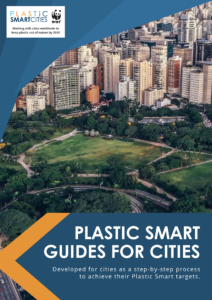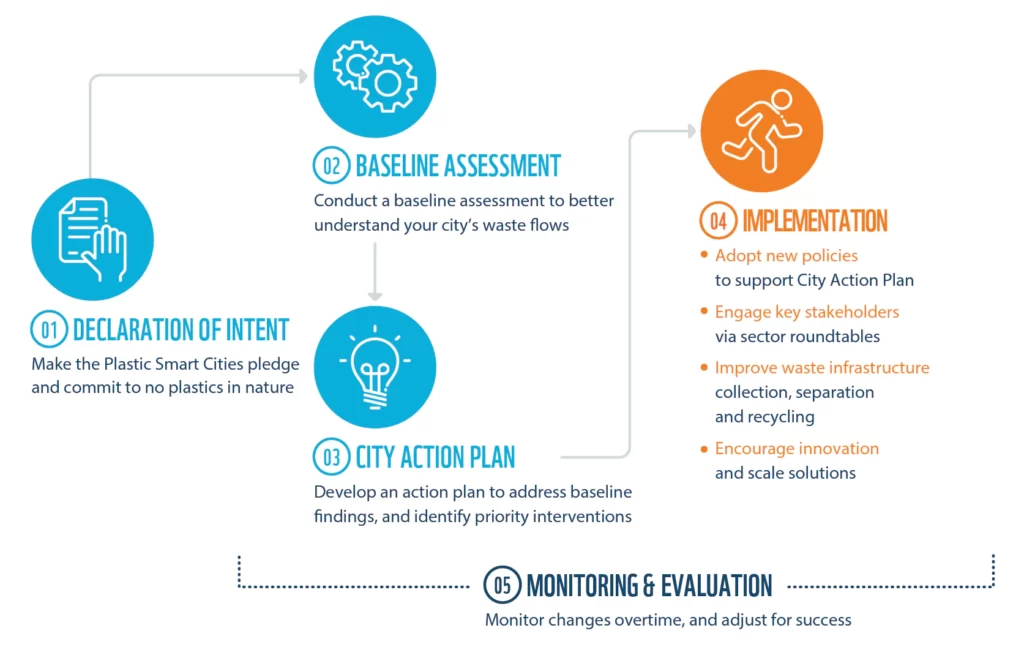Monitoring & Evaluation
Monitoring & Evaluation
This guidance was developed by the WWF Baseline & Monitoring Working Group in June 2021, to support cities as they identify key performance indicators to monitor and assess change over baseline conditions. The Monitoring and Evaluation plan closely aligns with the Baseline Assessment, and recommends third-party monitoring tools and internationally recognized guidelines.
Monitoring local waste streams is critical to developing sound city strategies. Gathering good data on the types and volumes of waste that are generated can help the city design suitable waste management programs, allocate resources to ensure appropriate collection infrastructure and scheduling, establish short and long-term targets for collection and diversion, and adapt as consumption patterns evolve. With good data, cities can better assess relevant technologies, applicable best practices given the local context, and identify strategic partners for service provisions.
Monitoring should be set as an on-going long-term process based on a series of repeated measurements made to detect the baseline condition and temporal changes in litter. Assessments use such information in a critical and contextualized way to design and evaluate the need for, and success of, public policies and mitigation measures.
The monitoring and evaluation approach should adhere to the Baseline Assessment methodology, as introduced in the Baseline Guidance, and as summarized below:
Waste Flow Monitoring Plan
The Waste Flow Monitoring Plan follows the same methodology, and seeks to answer the same research questions as the Waste Flow Scoping Assessment. The monitoring plan merely aims to update the initial assessment on an annual basis, to report changes over time.
Litter Monitoring Plan
The Litter Monitoring Plan follows the same methodology, and seeks to answer the same research questions as the Litter Baseline Assessment. The monitoring plan seeks to outline how and when to capture litter survey events at regularly scheduled intervals, to assess changes and impact over time, as compared to the baseline situation. The monitoring plan ensures that the same type of data can be collected at different stages in time, in order to compare the results and assess the extent of change, or lack thereof.
The Waste Flow Monitoring activities will replicate the Waste Flow Monitoring Assessment, using the same process, boundaries, level of resolution (low, medium, high) and using the same tools (e.g Waste Wise Cities Tool, Waste Flow Diagram, Wasteaware Benchmark Indicators, or others).
Similarly, the Litter Monitoring activities will replicate the Litter Baseline Assessment, using the same process, boundaries, level of resolution (low, medium, high) and using the same tools.
Prior to selecting your preferred litter monitoring tool, please consider the monitoring tool requirements listed below:
Requirements for Litter Monitoring Tools
- Method aligned with politically relevant and widely used methods
- Supported by leading science
- High resolution field forms/entries
- Low cost and replicable
- Flexibility: enables a tailor-made approach for specific cities/regions
- Option to engage the public and leverage citizen science
- Possibility to start quickly
Monitoring Tool Options
There are a host of monitoring tools available on the market, and with the many options on offer, it is important to consider the features of each tool in the context of your monitoring and evaluation approach, to ensure the selected tool meets your needs. In the Plastic Smart Guide, we include a brief comparative assessment of 3 tools according to some important criteria, but this table is not exhaustive, and can be used to compare and assess other tools as needed.
Learn to monitor and evaluate your city's progress
Plastic Smart Cities Framework
Follow the journey to becoming a Plastic Smart City. Find out more about other steps in the framework below.
Access the Plastic Smart Guide for Cities
Focused on how cities and local governments can start their journey on becoming plastic smart - complete with templates, actionable recommendations, as well as both framework and examples. Submit your information to access the Plastic Smart Guide.

